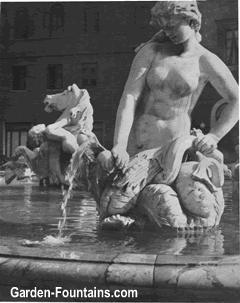 Bernini was quite ingenious. He was able to supply water to many Roman houses; he also received much of the water, a precious commodity, for free, because the Popes wanted to reward him for his many wonderful achievements regarding fountain and statuary creation. He was also very smart, in selling of this water privately. He had plans for older fountains, and plans for fountains he wanted to create, notable example being the “Triton fountain” and the Four Rivers Fountain”. He also made alterations to the Fountain of the Moor, which he began after finishing the Four Rivers Fountain, located at the center of the Piazza Navonna.
Bernini was quite ingenious. He was able to supply water to many Roman houses; he also received much of the water, a precious commodity, for free, because the Popes wanted to reward him for his many wonderful achievements regarding fountain and statuary creation. He was also very smart, in selling of this water privately. He had plans for older fountains, and plans for fountains he wanted to create, notable example being the “Triton fountain” and the Four Rivers Fountain”. He also made alterations to the Fountain of the Moor, which he began after finishing the Four Rivers Fountain, located at the center of the Piazza Navonna.
So what about the two older fountains located in the Piazza Navonna? An announcement was made on the day of the inauguration of the center fountain, the Fountain of the Four Rivers, that the older two fountains were to be restored from the ruined state they were in. They should be returned to the beauty that Pope Gregory XIII had originally made them to be.
The restoration of the Fountain of the Moor was done as a result of the elaborate new fountain, as well as the fact that the new Popes sister in law, Lady Olympia, lived in the palace whose windows overlooked the Fountain of the Moor.
An estimate was prepared for the cost of the restoration immediately. There was only a small estimate created, meaning the work needed to be done was minor. However in January 1652, Bernini had a series of sculptures made for the fountain. Bernini orders sculptor Angelo Vannelli to create a work consisting of three dolphins holding up a shell, from where the water flows.
This statue is named “The Snail” was the only change that was made to della Porta’s original model. It was originally felt that Bernini did not pay much attention or efforts in the idea of the “snail”. However on closer examination, it can be determined that Bernini got the idea from the amusing masks of della Porta, using that theme to twist the dolphins tails together, and adds the shell, echoing the look of the Barberini Triton.
The “Snail” was not attractive or enjoyed by either Pope Innocent X or Lady Olympia, and was quickly removed from the fountain. The Pope determined it to be inadequate in size for the fountain. It was overlooked in comparison to the Tritons, especially since the snail was to be the centerpiece. The “Snail” was given to Lady Olympia, who placed it in Villa Pamphili where it continues to remain to this day. Bernini, in the meantime, began to design and create another arrangement.
As Bernini began the reconstruction the basic shape of the fountain remained the same with the two steps running around the basin which was still surrounded by the balustrade, exactly as della Porta had designed it. Towards the end of 1654, as Bernini was ending the reconstruction process, it was determined that the statue of the Moor was too big for the basin, and Bernini decided the basins needed to be enlarged. Pope Innocent X gave order for 1000 scudi to be placed aside for the fountain to be embellished by making it larger and longer, in accordance to the design of Bernini.
To begin the new plan for restoring the Fountain of the Moor, Bernini decided to move away from the designs of della Porta, and follow a better model. The model was one where the pool was set at ground level, with sinuous lines much like that of the original basin, but water was accessed by spouts from two short steps on opposite sides of the fountain, with small platforms at the bottom. Bernini removed the steps and the Balustrude adding a wide pool echoing the lines of the basin, enclosing everything in a travertine border around the basin of the fountain. He then placed two travertine slabs in the pool to allow people access the water.
Bernini had requested that a peacock marble be used for the lip (the marble rim of the lower pool),which was a reddish purple color. But since the original basin was crafted from portsana marble, a reddish color, the lip will not stand out at all. So in 1708, during the time of Clement XI, a new restorer (Giovan Battista) removed the access platforms, and replaced the peacock marble lip with white marble.
So the restoration of the fountain is similar to that of a series of waves in the ocean. Changes were passively made, beginning with the center sculpture, to the lip of the pool, to the calming outer border. These changes create the Fountain of the Moor that exists today!
